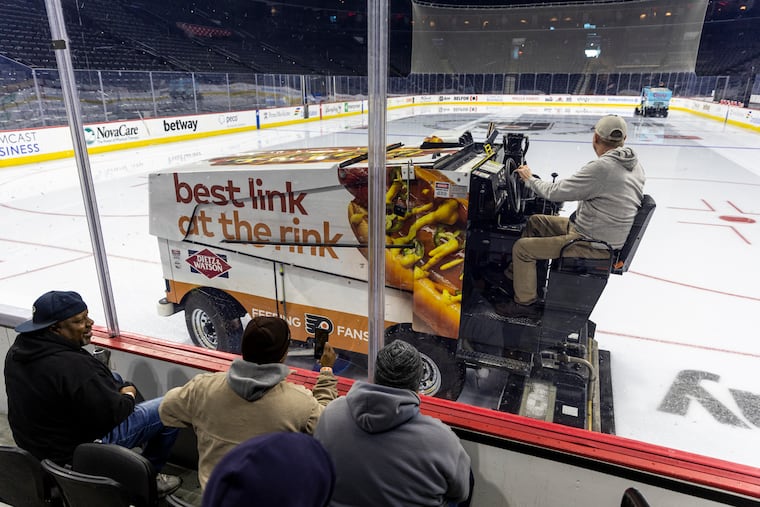Philly ice rink managers get a Zamboni master class from the Flyers’ operators
Several Parks and Recreation ice rink managers linked up with the Flyers' Zamboni operator to compare notes on ice maintenance.

Mabarak Levere, 49, gets animated when he starts talking about ice — the skating kind— and how to care for it, but there’s only so many people he can talk shop with as one of the five primary staffers maintaining Philadelphia’s five city-operated skating rinks.
If you count the people maintaining the private rinks around the city, Levere suspects you have 20 ice experts total. Naturally, he jumped at the chance of meeting the men in charge of maintaining the Flyers’ rink at the Wells Fargo Center Friday. He was joined by the other Parks and Recreation ice connoisseurs and the backups who pinch-hit when someone is off.
The event was arranged by the Flyers and nonprofit Ed Snider Youth Hockey & Education, which partners with Parks and Recreation for programming, to create an informal melding of the minds with hints of an ice master class. Levere got to pepper his hosts while watching them prep the ice for the Flyers.
“Learning new tricks and tips to be more efficient is welcome, we can bounce ideas off each other,” said Levere as he watched two men drive Zamboni and Olympia resurfacing machines around the Flyers’ rink in opposite synchronized swoops.
The machines, wrapped with Coors Light and Deitz & Watson advertising, are only one example of how much more of everything there is at the Wells Fargo Center — more staff, more equipment, more ceiling.
“We definitely don’t do that, this is next level for us!” said a delighted Levere to his peers at one point. They were watching two staffers take drills to the ice they’d just laid out in order to anchor some goal nets.
One of the drillers was Wells Fargo Center ice manager Chris Jennings — call him Young Freezie or vice president of liquid operations, he joked. Throughout the morning Jennings stressed his work is as much of an imperfect science as theirs, despite his larger workplace.
“Some of the stuff we do here, it’s different, it won’t compare to the community rink,” said Jennings. “But from the operational side, we try to drive home that we do the same thing, we’re all Zamboni operators.”
All drive clunky machines that can shave, wash, and apply new ice to create the perfect rink depending on expected usage, said Jennings. Whether it’s a community rink or the Wells Fargo Center, a lot of the judgment calls are based on a simple principle: know the schedule.
Rinks slated for children’s free skate won’t take a lot of dents or chips. The mid-skate pothole can be patched up with leftover “snow,” what the Zamboni operators call their ice shavings, until the next resurfacing.
A hockey-heavy week, however, requires ingenuity. It’ll likely call for thicker ice so it can take the thuds of pucks and those powerful skater landings, but create too thick an ice cap and you risk making the markings of a hockey field hard to see.
Much of the gathering is Parks and Rec ice managers peppering Jennings with questions. Blades alone got about 15 minutes of discussion. How often should they replace their resurfacing blades? Jennings tells them mileage may vary. He recommends switching up their patterns and routes on the Zamboni so as to keep the ice level. Going over the ice with a squeegee to clear the rink of debris or even bits of random food can help protect the Zamboni.
It’s all welcome advice to Shawn Drumwright, 56, who has been tending Philly’s rinks since 2004.
“When I got made they just handed me the keys,” he joked.
These days newbies like Curtis Gibbs, 54, learn in a veteran-teaches-the-rookie model. Gibbs said he’s “not made yet” with less than a year as a backup at Tarken Ice Rink, but with the help of his mentor Levere, he feels good about his prospects should someone retire. He’s even considering learning how to ice skate.
For Gibbs, the informal refresher and opportunity to mingle with vets of the ice are especially helpful because as a backup, he could find himself in any of Parks and Recreation’s five rinks, each with different quirks, from where to park to where to dump your ice shavings.
During natural breaks in the gathering, the Zamboni operators describe the fun but odd nature of the job to uninitiated reporters and flacks.
“It’s like driving in the trunk of your car instead of a front seat,” said Levere, definitely not a job many imagined they’d have and be so passionate about.
“Best kept secret in Philly,” said Walter Griffin, 60, who’s been caring for rinks for eight years and is currently at Laura Sims Skatehouse.
The rinks are open most of the year, closing in the height of summer, and opening again in the fall.
“If you have your own skates, you could skate for free.”